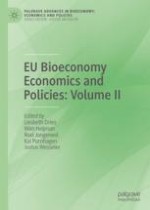2019 | Buch
EU Bioeconomy Economics and Policies: Volume II
herausgegeben von: Dr. Liesbeth Dries, Prof. Wim Heijman, Prof. Roel Jongeneel, Assoc. Prof. Kai Purnhagen, Prof. Dr. Justus Wesseler
Verlag: Springer International Publishing
Buchreihe : Palgrave Advances in Bioeconomy: Economics and Policies
